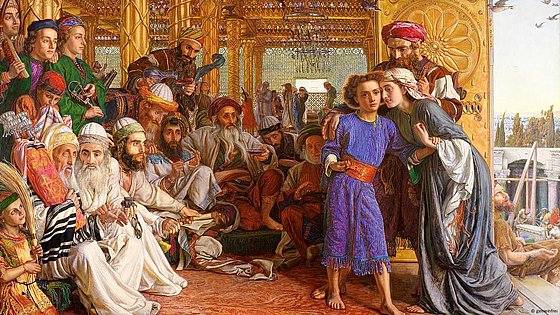
A spiritually gifted child
Prof Dr Kurt Erlemann / Protestant Theology
Photo: Sebastian Jarych
A spiritually gifted child
Theologian Kurt Erlemann on the unknown childhood of Jesus
The Bible tells us about Jesus' birth; the evangelists Matthew, Mark, Luke, and John tell us about the adult 30 to 40-year-old Son of God. But what do we know about the child? “No idea”, the Wuppertal theologian Kurt Erlemann answers this question spontaneously. There is actually no historically reliable source that provides any information about Jesus. “I suspect he was quite normal,” the scientist says, “at least that's what we can gather from an episode in Mark 6, verses 1-6 (Jesus in Nazareth), where his former neighbours and friends mock him along the lines of: 'What? He says he's the Son of God and can perform miracles? No, he certainly can't.' So, he seems to have been just a normal rascal from the neighbourhood. The only thing we know is that he was obedient to his mother. At least that's what the Gospel of Luke chapter 2, verse 51 says. That's all we can say, and even this information is difficult to verify because the sources we have are testimonies and not historical diaries.”
Only one childhood story is found in the Gospel of Luke
In the Bible; more specifically in the Gospel of Luke, there is only one story about the young Jesus. It is that of the twelve-year-old boy who impresses the scribes in the temple with his intelligence. It seems to have been the only childhood event that the evangelist Luke regarded as theologically meaningful, Erlemann surmises. It shows Jesus' authority to interpret the Scriptures from an early age, without having completed a scribal training. “He was spiritually gifted! This can already be seen in Luke 1-3 at his conception and baptism. He receives the Holy Spirit, and the authorised interpretation of Scripture is the first manifestation of his spiritual gift. Luke wants to show this here. The Spirit is stronger than professional training as a theologian or scribe.” The story shows Jesus' prophetic destiny because what he is doing in the temple is actually holding up a mirror to temple theology. “He is saying that he has a claim to the temple. He is implicitly criticising the temple, and this shows Jesus' prophetic claim.”
Jesus' childhood is missing from the canonical writings
Apart from this one temple story, there is no other childhood story in the canonical writings of the Bible. Erlemann explains that this is simply because this phase of his life is theologically unproductive. “What can be said about him theologically and in terms of a testimony of faith becomes visible in adulthood. In his youth he was just a normal boy. You don't need to repeat that in a gospel.”
Childhood gospels
In fact, there are even several childhood gospels. “There is a so-called Protevangelium of James,” Erlemann explains, “or the Arabic Infancy Gospel. But the best known is certainly the Infancy Gospel of Thomas. This gospel is apocryphal, meaning it does not belong in the canon of the Holy Scriptures, and contains many legends about the young boy Jesus, who was able to perform miracles from an early age.” Some of these miracles are also quite strange, miracles that can be confused because Heracles and Buddha also performed similar miracles. “The point is to prove in the legends that Jesus was at least as capable of performing miracles as his 'colleagues' from the Greek myths. There are numerous legends in this childhood gospel. Chapter 9, for example, is about the revival of a playmate who had had an accident. He falls off a flat roof while playing ball and is dead. Jesus is then accused by the boy's parents of having killed him, and Jesus wakes him up again so that the boy can say that Jesus is not to blame.” In another story Jesus created twelve sparrows out of clay at the age of five. “It is annoying that he made them on a Sabbath. There is a reference to the Synoptic Gospels, because Jesus often performs miracles on the Sabbath and therefore gets into trouble with the religious leaders. His father gets very upset, too, whereupon the boy transforms the sparrows into living birds that fly away, so that everyone is amazed at what this little boy can do.” In another story, he curses a teacher who gets on his nerves because he is trying to teach him the alphabet, which he already knows. The teacher is totally desperate and asks the parents to take the child back with them, as he already has all the wisdom in the world. “At this point, he already has the miraculous power that he also has as an adult.”

Jesus in the temple - one of the few New Testament scenes set in childhood, photo: public domain
Creating legends instead of theological enrichment
The Infancy Gospel of Thomas was even banned by the popes in the fourth century in the so-called Decretum Gelasianum. “In 382 CE, the scope of the New Testament canon was defined,” the theologian explains, ”and a distinction was made between canonical sacred writings and those that did not fit into this category.” This infancy gospel is full of legends, and this was already recognised at the time. Today we would call them 'media-rich miracles', which are not about theological enrichment. “There are so many gospels that were written at the time that go in exactly this direction, and people knew even back then that these stories would not help the churches move forward. It's like social media today. You get a lot of clicks when unbelievable things are spread. People are just like that. They have always had a curiosity for such great stories, but they are not covered by any history.”
Text fragment of the Infancy Gospel of Thomas discovered in Hamburg in 2024
In 2024, researchers in Hamburg discovered a text fragment about the youth of Jesus, which was widely reported in the press. “It is a small fragment from the Infancy Gospel of Thomas, which was rediscovered in the Hamburg State and University Library after lying there for many years. It could be dated to the fourth or fifth century, which makes it older than the fragments of this gospel that were previously known. It can be said that the original form of this gospel was not Syriac or Coptic, but Greek. The gospel was probably written towards the end of the 2nd century, when the formation of legends was in full swing. It belongs to this category, i.e., to the older apocrypha” Erlmann explains.
The story of Jesus as a child can also be found in the Koran
“We know that the Koran actually draws on apocrypha from Christian sources,” Erlemann says. “The Prophet Muhammad's knowledge of Christianity did not come from the teachings of early Catholicism based in Rome, but from remote Christian splinter groups that were at home on the Arabian Peninsula at the time.” From there, these legendary stories spread further. “For the Quran, the fact that Jesus was able to bring these clay pigeons to life is an example of how God Almighty can authorise a person to perform miracles. The Koran is not about depicting the deity of Jesus - in contrast to the apocryphal accounts in Christianity - but about God, who is omnipotent and who, in his omnipotence, also temporarily confers such an ability on a human being. We know that Jesus has a very special position in Islam, but he is not the son of God. He was a prophet and God was close to him and occasionally gave him the gift of being able to perform miracles.”
Children in the religious world
Depictions of childhood in antiquity are generally different from today's descriptions. “Children didn't play the role that 21st century children play in Germany. I always say that we older people grew up in a parent-centred world. Today we live in a child-centred world. In ancient times, it was much more parent-centred.” From other contexts in antiquity, we know that children were primarily the parents' old-age provision and not people with their own personality. They were not fully-fledged people, they were at a stage before they were actually human, belonged to their parents as property and had to do what they said.
The blessing of children in Mark 10:13-16, which is recited at baptisms where Jesus blesses the children, testifies to this. “Some parents bring children to Jesus and the disciples get angry and ask the parents to take the children back with them. Children were not valued and Jesus reverses this at that moment. He says: `Let the children come to me, and do not hinder them, for the Kingdom of God belongs to such as these. The children are elevated at the expense of the disciples, who at that moment no longer understood the world. Jesus places the children at the centre as an example of faith. Through them you enter the Kingdom of God. That was a revolution!”
Uwe Blass
Prof Dr Kurt Erlemann was head of the Department of New Testament and History of the Early Church at the University of Wuppertal.
